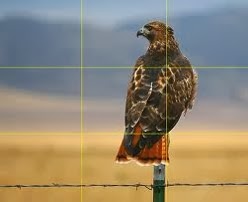方法 :
1. 先將影像依據三分法,找出四個交叉點,並以該四點為中心形成四個block
2. 方法: 接著計算各個block的Saliency map,我們認為Saliency value 最大的block就是該影像主要內容的位置。
Saliency (影像顯著性) 公式 : S(x,y) = | Iu-Iwhc(x,y) |。
S(x,y): 像素在座標(x,y)上的Saliency value。
Iu: 一張相片的平均像素強度( in lab color space)。
Iwhc: 經過高斯模糊後,像素在座標(x,y)上強度值(in lab color space)
參考論文 : R. Achanta, S. Hemami, F. Estrada, and S. Susstrunk. Frequency-tuned salient region detection. In Computer Vision and Pattern Recognition, 2009. CVPR 2009.IEEE Conference on, pages 1597 –1604, june 2009.
3. 計算最終三分法的值
公式 : Frot = average( max saliency of block ) / average( saliency of image )
4. 程式碼
環境 : visual studio 2010、opencv 2.4.7
測試資料: 取自下列文獻所提供之資料的前1000張影像
N. Murray, L. Marchesotti, and F. Perronnin, “AVA: A Large-Scale Database for Aesthetic Visual Analysis,” CVPR, 2012.
#include <iostream> // for standard I/O
#include <string> // for strings
#include <vector>
#include <cmath>
#include <ctime>
#include <fstream>
#include <opencv2/imgproc/imgproc.hpp> // Gaussian Blur
#include <opencv2/core/core.hpp> // Basic OpenCV structures (cv::Mat, Scalar)
#include <opencv2/highgui/highgui.hpp> // OpenCV window I/O
#include "opencv2/features2d/features2d.hpp"
using namespace std;
using namespace cv;
int main(int argc, char *argv[])
{
fstream fout;
fout.open("Frot.txt",ios::out);
string image_name;
char arr[50];
int i,j,k;
double l,a,b;
double mean_l,mean_a,mean_b;
double rows,cols;
double aver_saliency_max;
double temp;
Mat ori_image,img_blur,img_Lab,image_saliency_output ;
for(k=0;k<=999;k++) //1000 test image
{
/**********construct Saliency map****************/
sprintf(arr,"ava_photos/%d.jpg",k);
image_name.assign(arr);
cout << image_name << endl;
ori_image = imread ( image_name, CV_LOAD_IMAGE_COLOR );
cvtColor( ori_image, img_Lab, CV_BGR2Lab );
GaussianBlur(img_Lab, img_blur, Size(5,5),0,0 );
mean_l=0;
mean_a=0;
mean_b=0;
rows = ori_image.rows;
cols = ori_image.cols;
image_saliency_output = Mat(rows,cols,CV_8U);
for(i=0;i<rows;i++)
{
for(j=0;j<cols;j++)
{
mean_l += img_Lab.at<Vec3b> (i,j).val[0];
mean_a += img_Lab.at<Vec3b> (i,j).val[1];
mean_b += img_Lab.at<Vec3b> (i,j).val[2];
}
}
mean_l = mean_l/(rows*cols);
mean_a = mean_a/(rows*cols);
mean_b = mean_b/(rows*cols);
for(i=0;i<rows;i++)
{
for(j=0;j<cols;j++)
{
l = mean_l - img_blur.at<Vec3b> (i,j).val[0];
a = mean_a - img_blur.at<Vec3b> (i,j).val[1];
b = mean_b - img_blur.at<Vec3b> (i,j).val[2];
image_saliency_output.at<uchar> (i,j) = sqrt( l*l + a*a + b*b );
}
}
/*********end Saliency map**************/
aver_saliency_max = -1;
/********compute left-up segment average saliency value*********/
temp = 0;
for(i=rows/3-rows/6;i<=rows/3+rows/6;i++)
{
for(j=cols/3-cols/6;j<=cols/3+cols/6;j++)
{
temp += image_saliency_output.at<uchar> (i,j);
}
}
if( temp >= aver_saliency_max )
aver_saliency_max = temp;
/*******compute right-up segment average saliency value*********/
temp = 0;
for(i=rows/3-rows/6;i<=rows/3+rows/6;i++)
{
for(j=cols/3*2-cols/6;j<=cols/3*2+cols/6;j++)
{
temp += image_saliency_output.at<uchar> (i,j);
}
}
if( temp >= aver_saliency_max )
aver_saliency_max = temp;
/******compute left-down segment average saliency value*********/
temp = 0;
for(i=rows/3*2-rows/6;i<=rows/3*2+rows/6;i++)
{
for(j=cols/3-cols/6;j<=cols/3+cols/6;j++)
{
temp += image_saliency_output.at<uchar> (i,j);
}
}
if( temp >= aver_saliency_max )
aver_saliency_max = temp;
/******compute right-down segment average saliency value*******/
temp = 0;
for(i=rows/3*2-rows/6;i<=rows/3*2+rows/6;i++)
{
for(j=cols/3*2-cols/6;j<=cols/3*2+cols/6;j++)
{
temp += image_saliency_output.at<uchar> (i,j);
}
}
if( temp >= aver_saliency_max )
aver_saliency_max = temp;
/********compute image's all average saliency value************/
temp = 0;
for(i=0;i<rows;i++)
{
for(j=0;j<cols;j++)
{
temp += image_saliency_output.at<uchar> (i,j);
}
}
/***********************compute Frot***************************/
aver_saliency_max = aver_saliency_max/temp;
fout << k << ".jpg " << aver_saliency_max << endl;
}
system("pause");
return 0;
}
5. final top 5 image of frot in ava_photos images
6. final last 5 image of frot in ava_photos images













沒有留言:
張貼留言